-
EXECUTIVE SUMMARY
-
Market Overview
-
Key Findings
-
Market Segmentation
-
Competitive Landscape
-
Challenges and Opportunities
-
Future Outlook
-
MARKET INTRODUCTION
-
Definition
-
Scope of the study
- Research Objective
- Assumption
- Limitations
-
RESEARCH METHODOLOGY
-
Overview
-
Data Mining
-
Secondary Research
-
Primary Research
- Primary Interviews and Information Gathering Process
- Breakdown of Primary Respondents
-
Forecasting Model
-
Market Size Estimation
- Bottom-Up Approach
- Top-Down Approach
-
Data Triangulation
-
Validation
-
MARKET DYNAMICS
-
Overview
-
Drivers
-
Restraints
-
Opportunities
-
MARKET FACTOR ANALYSIS
-
Value chain Analysis
-
Porter's Five Forces Analysis
- Bargaining Power of Suppliers
- Bargaining Power of Buyers
- Threat of New Entrants
- Threat of Substitutes
- Intensity of Rivalry
-
COVID-19 Impact Analysis
- Market Impact Analysis
- Regional Impact
- Opportunity and Threat Analysis
-
INDUSTRIAL ACCESS CONTROL MARKET, BY TECHNOLOGY (USD BILLION)
-
Biometric Systems
-
Card-Based Systems
-
Smart Locks
-
Keypad Entry Systems
-
INDUSTRIAL ACCESS CONTROL MARKET, BY DEPLOYMENT TYPE (USD BILLION)
-
On-Premises
-
Cloud-Based
-
INDUSTRIAL ACCESS CONTROL MARKET, BY END USE (USD BILLION)
-
Manufacturing
-
Healthcare
-
Government
-
Retail
-
INDUSTRIAL ACCESS CONTROL MARKET, BY COMPONENT (USD BILLION)
-
Hardware
-
Software
-
Services
-
INDUSTRIAL ACCESS CONTROL MARKET, BY REGIONAL (USD BILLION)
-
North America
- US
- Canada
-
Europe
- Germany
- UK
- France
- Russia
- Italy
- Spain
- Rest of Europe
-
APAC
- China
- India
- Japan
- South Korea
- Malaysia
- Thailand
- Indonesia
- Rest of APAC
-
South America
- Brazil
- Mexico
- Argentina
- Rest of South America
-
MEA
- GCC Countries
- South Africa
- Rest of MEA
-
COMPETITIVE LANDSCAPE
-
Overview
-
Competitive Analysis
-
Market share Analysis
-
Major Growth Strategy in the Industrial Access Control Market
-
Competitive Benchmarking
-
Leading Players in Terms of Number of Developments in the Industrial Access Control Market
-
Key developments and growth strategies
- New Product Launch/Service Deployment
- Merger & Acquisitions
- Joint Ventures
-
Major Players Financial Matrix
- Sales and Operating Income
- Major Players R&D Expenditure. 2023
-
COMPANY PROFILES
-
Tyco International
- Financial Overview
- Products Offered
- Key Developments
- SWOT Analysis
- Key Strategies
-
Siemens
- Financial Overview
- Products Offered
- Key Developments
- SWOT Analysis
- Key Strategies
-
Stanley Black and Decker
- Financial Overview
- Products Offered
- Key Developments
- SWOT Analysis
- Key Strategies
-
AlertEnterprise
- Financial Overview
- Products Offered
- Key Developments
- SWOT Analysis
- Key Strategies
-
Dahua Technology
- Financial Overview
- Products Offered
- Key Developments
- SWOT Analysis
- Key Strategies
-
Fujitsu
- Financial Overview
- Products Offered
- Key Developments
- SWOT Analysis
- Key Strategies
-
Thales Group
- Financial Overview
- Products Offered
- Key Developments
- SWOT Analysis
- Key Strategies
-
Johnson Controls
- Financial Overview
- Products Offered
- Key Developments
- SWOT Analysis
- Key Strategies
-
ASSA ABLOY
- Financial Overview
- Products Offered
- Key Developments
- SWOT Analysis
- Key Strategies
-
Honeywell
- Financial Overview
- Products Offered
- Key Developments
- SWOT Analysis
- Key Strategies
-
Bosch Security Systems
- Financial Overview
- Products Offered
- Key Developments
- SWOT Analysis
- Key Strategies
-
Hikvision
- Financial Overview
- Products Offered
- Key Developments
- SWOT Analysis
- Key Strategies
-
Magal Security Systems
- Financial Overview
- Products Offered
- Key Developments
- SWOT Analysis
- Key Strategies
-
Motorola Solutions
- Financial Overview
- Products Offered
- Key Developments
- SWOT Analysis
- Key Strategies
-
Gemalto
- Financial Overview
- Products Offered
- Key Developments
- SWOT Analysis
- Key Strategies
-
APPENDIX
-
References
-
Related Reports
-
LIST OF TABLES
-
LIST OF ASSUMPTIONS
-
NORTH AMERICA INDUSTRIAL ACCESS CONTROL MARKET SIZE ESTIMATES & FORECAST, BY TECHNOLOGY, 2019-2032 (USD BILLIONS)
-
NORTH AMERICA INDUSTRIAL ACCESS CONTROL MARKET SIZE ESTIMATES & FORECAST, BY DEPLOYMENT TYPE, 2019-2032 (USD BILLIONS)
-
NORTH AMERICA INDUSTRIAL ACCESS CONTROL MARKET SIZE ESTIMATES & FORECAST, BY END USE, 2019-2032 (USD BILLIONS)
-
NORTH AMERICA INDUSTRIAL ACCESS CONTROL MARKET SIZE ESTIMATES & FORECAST, BY COMPONENT, 2019-2032 (USD BILLIONS)
-
NORTH AMERICA INDUSTRIAL ACCESS CONTROL MARKET SIZE ESTIMATES & FORECAST, BY REGIONAL, 2019-2032 (USD BILLIONS)
-
US INDUSTRIAL ACCESS CONTROL MARKET SIZE ESTIMATES & FORECAST, BY TECHNOLOGY, 2019-2032 (USD BILLIONS)
-
US INDUSTRIAL ACCESS CONTROL MARKET SIZE ESTIMATES & FORECAST, BY DEPLOYMENT TYPE, 2019-2032 (USD BILLIONS)
-
US INDUSTRIAL ACCESS CONTROL MARKET SIZE ESTIMATES & FORECAST, BY END USE, 2019-2032 (USD BILLIONS)
-
US INDUSTRIAL ACCESS CONTROL MARKET SIZE ESTIMATES & FORECAST, BY COMPONENT, 2019-2032 (USD BILLIONS)
-
US INDUSTRIAL ACCESS CONTROL MARKET SIZE ESTIMATES & FORECAST, BY REGIONAL, 2019-2032 (USD BILLIONS)
-
CANADA INDUSTRIAL ACCESS CONTROL MARKET SIZE ESTIMATES & FORECAST, BY TECHNOLOGY, 2019-2032 (USD BILLIONS)
-
CANADA INDUSTRIAL ACCESS CONTROL MARKET SIZE ESTIMATES & FORECAST, BY DEPLOYMENT TYPE, 2019-2032 (USD BILLIONS)
-
CANADA INDUSTRIAL ACCESS CONTROL MARKET SIZE ESTIMATES & FORECAST, BY END USE, 2019-2032 (USD BILLIONS)
-
CANADA INDUSTRIAL ACCESS CONTROL MARKET SIZE ESTIMATES & FORECAST, BY COMPONENT, 2019-2032 (USD BILLIONS)
-
CANADA INDUSTRIAL ACCESS CONTROL MARKET SIZE ESTIMATES & FORECAST, BY REGIONAL, 2019-2032 (USD BILLIONS)
-
EUROPE INDUSTRIAL ACCESS CONTROL MARKET SIZE ESTIMATES & FORECAST, BY TECHNOLOGY, 2019-2032 (USD BILLIONS)
-
EUROPE INDUSTRIAL ACCESS CONTROL MARKET SIZE ESTIMATES & FORECAST, BY DEPLOYMENT TYPE, 2019-2032 (USD BILLIONS)
-
EUROPE INDUSTRIAL ACCESS CONTROL MARKET SIZE ESTIMATES & FORECAST, BY END USE, 2019-2032 (USD BILLIONS)
-
EUROPE INDUSTRIAL ACCESS CONTROL MARKET SIZE ESTIMATES & FORECAST, BY COMPONENT, 2019-2032 (USD BILLIONS)
-
EUROPE INDUSTRIAL ACCESS CONTROL MARKET SIZE ESTIMATES & FORECAST, BY REGIONAL, 2019-2032 (USD BILLIONS)
-
GERMANY INDUSTRIAL ACCESS CONTROL MARKET SIZE ESTIMATES & FORECAST, BY TECHNOLOGY, 2019-2032 (USD BILLIONS)
-
GERMANY INDUSTRIAL ACCESS CONTROL MARKET SIZE ESTIMATES & FORECAST, BY DEPLOYMENT TYPE, 2019-2032 (USD BILLIONS)
-
GERMANY INDUSTRIAL ACCESS CONTROL MARKET SIZE ESTIMATES & FORECAST, BY END USE, 2019-2032 (USD BILLIONS)
-
GERMANY INDUSTRIAL ACCESS CONTROL MARKET SIZE ESTIMATES & FORECAST, BY COMPONENT, 2019-2032 (USD BILLIONS)
-
GERMANY INDUSTRIAL ACCESS CONTROL MARKET SIZE ESTIMATES & FORECAST, BY REGIONAL, 2019-2032 (USD BILLIONS)
-
UK INDUSTRIAL ACCESS CONTROL MARKET SIZE ESTIMATES & FORECAST, BY TECHNOLOGY, 2019-2032 (USD BILLIONS)
-
UK INDUSTRIAL ACCESS CONTROL MARKET SIZE ESTIMATES & FORECAST, BY DEPLOYMENT TYPE, 2019-2032 (USD BILLIONS)
-
UK INDUSTRIAL ACCESS CONTROL MARKET SIZE ESTIMATES & FORECAST, BY END USE, 2019-2032 (USD BILLIONS)
-
UK INDUSTRIAL ACCESS CONTROL MARKET SIZE ESTIMATES & FORECAST, BY COMPONENT, 2019-2032 (USD BILLIONS)
-
UK INDUSTRIAL ACCESS CONTROL MARKET SIZE ESTIMATES & FORECAST, BY REGIONAL, 2019-2032 (USD BILLIONS)
-
FRANCE INDUSTRIAL ACCESS CONTROL MARKET SIZE ESTIMATES & FORECAST, BY TECHNOLOGY, 2019-2032 (USD BILLIONS)
-
FRANCE INDUSTRIAL ACCESS CONTROL MARKET SIZE ESTIMATES & FORECAST, BY DEPLOYMENT TYPE, 2019-2032 (USD BILLIONS)
-
FRANCE INDUSTRIAL ACCESS CONTROL MARKET SIZE ESTIMATES & FORECAST, BY END USE, 2019-2032 (USD BILLIONS)
-
FRANCE INDUSTRIAL ACCESS CONTROL MARKET SIZE ESTIMATES & FORECAST, BY COMPONENT, 2019-2032 (USD BILLIONS)
-
FRANCE INDUSTRIAL ACCESS CONTROL MARKET SIZE ESTIMATES & FORECAST, BY REGIONAL, 2019-2032 (USD BILLIONS)
-
RUSSIA INDUSTRIAL ACCESS CONTROL MARKET SIZE ESTIMATES & FORECAST, BY TECHNOLOGY, 2019-2032 (USD BILLIONS)
-
RUSSIA INDUSTRIAL ACCESS CONTROL MARKET SIZE ESTIMATES & FORECAST, BY DEPLOYMENT TYPE, 2019-2032 (USD BILLIONS)
-
RUSSIA INDUSTRIAL ACCESS CONTROL MARKET SIZE ESTIMATES & FORECAST, BY END USE, 2019-2032 (USD BILLIONS)
-
RUSSIA INDUSTRIAL ACCESS CONTROL MARKET SIZE ESTIMATES & FORECAST, BY COMPONENT, 2019-2032 (USD BILLIONS)
-
RUSSIA INDUSTRIAL ACCESS CONTROL MARKET SIZE ESTIMATES & FORECAST, BY REGIONAL, 2019-2032 (USD BILLIONS)
-
ITALY INDUSTRIAL ACCESS CONTROL MARKET SIZE ESTIMATES & FORECAST, BY TECHNOLOGY, 2019-2032 (USD BILLIONS)
-
ITALY INDUSTRIAL ACCESS CONTROL MARKET SIZE ESTIMATES & FORECAST, BY DEPLOYMENT TYPE, 2019-2032 (USD BILLIONS)
-
ITALY INDUSTRIAL ACCESS CONTROL MARKET SIZE ESTIMATES & FORECAST, BY END USE, 2019-2032 (USD BILLIONS)
-
ITALY INDUSTRIAL ACCESS CONTROL MARKET SIZE ESTIMATES & FORECAST, BY COMPONENT, 2019-2032 (USD BILLIONS)
-
ITALY INDUSTRIAL ACCESS CONTROL MARKET SIZE ESTIMATES & FORECAST, BY REGIONAL, 2019-2032 (USD BILLIONS)
-
SPAIN INDUSTRIAL ACCESS CONTROL MARKET SIZE ESTIMATES & FORECAST, BY TECHNOLOGY, 2019-2032 (USD BILLIONS)
-
SPAIN INDUSTRIAL ACCESS CONTROL MARKET SIZE ESTIMATES & FORECAST, BY DEPLOYMENT TYPE, 2019-2032 (USD BILLIONS)
-
SPAIN INDUSTRIAL ACCESS CONTROL MARKET SIZE ESTIMATES & FORECAST, BY END USE, 2019-2032 (USD BILLIONS)
-
SPAIN INDUSTRIAL ACCESS CONTROL MARKET SIZE ESTIMATES & FORECAST, BY COMPONENT, 2019-2032 (USD BILLIONS)
-
SPAIN INDUSTRIAL ACCESS CONTROL MARKET SIZE ESTIMATES & FORECAST, BY REGIONAL, 2019-2032 (USD BILLIONS)
-
REST OF EUROPE INDUSTRIAL ACCESS CONTROL MARKET SIZE ESTIMATES & FORECAST, BY TECHNOLOGY, 2019-2032 (USD BILLIONS)
-
REST OF EUROPE INDUSTRIAL ACCESS CONTROL MARKET SIZE ESTIMATES & FORECAST, BY DEPLOYMENT TYPE, 2019-2032 (USD BILLIONS)
-
REST OF EUROPE INDUSTRIAL ACCESS CONTROL MARKET SIZE ESTIMATES & FORECAST, BY END USE, 2019-2032 (USD BILLIONS)
-
REST OF EUROPE INDUSTRIAL ACCESS CONTROL MARKET SIZE ESTIMATES & FORECAST, BY COMPONENT, 2019-2032 (USD BILLIONS)
-
REST OF EUROPE INDUSTRIAL ACCESS CONTROL MARKET SIZE ESTIMATES & FORECAST, BY REGIONAL, 2019-2032 (USD BILLIONS)
-
APAC INDUSTRIAL ACCESS CONTROL MARKET SIZE ESTIMATES & FORECAST, BY TECHNOLOGY, 2019-2032 (USD BILLIONS)
-
APAC INDUSTRIAL ACCESS CONTROL MARKET SIZE ESTIMATES & FORECAST, BY DEPLOYMENT TYPE, 2019-2032 (USD BILLIONS)
-
APAC INDUSTRIAL ACCESS CONTROL MARKET SIZE ESTIMATES & FORECAST, BY END USE, 2019-2032 (USD BILLIONS)
-
APAC INDUSTRIAL ACCESS CONTROL MARKET SIZE ESTIMATES & FORECAST, BY COMPONENT, 2019-2032 (USD BILLIONS)
-
APAC INDUSTRIAL ACCESS CONTROL MARKET SIZE ESTIMATES & FORECAST, BY REGIONAL, 2019-2032 (USD BILLIONS)
-
CHINA INDUSTRIAL ACCESS CONTROL MARKET SIZE ESTIMATES & FORECAST, BY TECHNOLOGY, 2019-2032 (USD BILLIONS)
-
CHINA INDUSTRIAL ACCESS CONTROL MARKET SIZE ESTIMATES & FORECAST, BY DEPLOYMENT TYPE, 2019-2032 (USD BILLIONS)
-
CHINA INDUSTRIAL ACCESS CONTROL MARKET SIZE ESTIMATES & FORECAST, BY END USE, 2019-2032 (USD BILLIONS)
-
CHINA INDUSTRIAL ACCESS CONTROL MARKET SIZE ESTIMATES & FORECAST, BY COMPONENT, 2019-2032 (USD BILLIONS)
-
CHINA INDUSTRIAL ACCESS CONTROL MARKET SIZE ESTIMATES & FORECAST, BY REGIONAL, 2019-2032 (USD BILLIONS)
-
INDIA INDUSTRIAL ACCESS CONTROL MARKET SIZE ESTIMATES & FORECAST, BY TECHNOLOGY, 2019-2032 (USD BILLIONS)
-
INDIA INDUSTRIAL ACCESS CONTROL MARKET SIZE ESTIMATES & FORECAST, BY DEPLOYMENT TYPE, 2019-2032 (USD BILLIONS)
-
INDIA INDUSTRIAL ACCESS CONTROL MARKET SIZE ESTIMATES & FORECAST, BY END USE, 2019-2032 (USD BILLIONS)
-
INDIA INDUSTRIAL ACCESS CONTROL MARKET SIZE ESTIMATES & FORECAST, BY COMPONENT, 2019-2032 (USD BILLIONS)
-
INDIA INDUSTRIAL ACCESS CONTROL MARKET SIZE ESTIMATES & FORECAST, BY REGIONAL, 2019-2032 (USD BILLIONS)
-
JAPAN INDUSTRIAL ACCESS CONTROL MARKET SIZE ESTIMATES & FORECAST, BY TECHNOLOGY, 2019-2032 (USD BILLIONS)
-
JAPAN INDUSTRIAL ACCESS CONTROL MARKET SIZE ESTIMATES & FORECAST, BY DEPLOYMENT TYPE, 2019-2032 (USD BILLIONS)
-
JAPAN INDUSTRIAL ACCESS CONTROL MARKET SIZE ESTIMATES & FORECAST, BY END USE, 2019-2032 (USD BILLIONS)
-
JAPAN INDUSTRIAL ACCESS CONTROL MARKET SIZE ESTIMATES & FORECAST, BY COMPONENT, 2019-2032 (USD BILLIONS)
-
JAPAN INDUSTRIAL ACCESS CONTROL MARKET SIZE ESTIMATES & FORECAST, BY REGIONAL, 2019-2032 (USD BILLIONS)
-
SOUTH KOREA INDUSTRIAL ACCESS CONTROL MARKET SIZE ESTIMATES & FORECAST, BY TECHNOLOGY, 2019-2032 (USD BILLIONS)
-
SOUTH KOREA INDUSTRIAL ACCESS CONTROL MARKET SIZE ESTIMATES & FORECAST, BY DEPLOYMENT TYPE, 2019-2032 (USD BILLIONS)
-
SOUTH KOREA INDUSTRIAL ACCESS CONTROL MARKET SIZE ESTIMATES & FORECAST, BY END USE, 2019-2032 (USD BILLIONS)
-
SOUTH KOREA INDUSTRIAL ACCESS CONTROL MARKET SIZE ESTIMATES & FORECAST, BY COMPONENT, 2019-2032 (USD BILLIONS)
-
SOUTH KOREA INDUSTRIAL ACCESS CONTROL MARKET SIZE ESTIMATES & FORECAST, BY REGIONAL, 2019-2032 (USD BILLIONS)
-
MALAYSIA INDUSTRIAL ACCESS CONTROL MARKET SIZE ESTIMATES & FORECAST, BY TECHNOLOGY, 2019-2032 (USD BILLIONS)
-
MALAYSIA INDUSTRIAL ACCESS CONTROL MARKET SIZE ESTIMATES & FORECAST, BY DEPLOYMENT TYPE, 2019-2032 (USD BILLIONS)
-
MALAYSIA INDUSTRIAL ACCESS CONTROL MARKET SIZE ESTIMATES & FORECAST, BY END USE, 2019-2032 (USD BILLIONS)
-
MALAYSIA INDUSTRIAL ACCESS CONTROL MARKET SIZE ESTIMATES & FORECAST, BY COMPONENT, 2019-2032 (USD BILLIONS)
-
MALAYSIA INDUSTRIAL ACCESS CONTROL MARKET SIZE ESTIMATES & FORECAST, BY REGIONAL, 2019-2032 (USD BILLIONS)
-
THAILAND INDUSTRIAL ACCESS CONTROL MARKET SIZE ESTIMATES & FORECAST, BY TECHNOLOGY, 2019-2032 (USD BILLIONS)
-
THAILAND INDUSTRIAL ACCESS CONTROL MARKET SIZE ESTIMATES & FORECAST, BY DEPLOYMENT TYPE, 2019-2032 (USD BILLIONS)
-
THAILAND INDUSTRIAL ACCESS CONTROL MARKET SIZE ESTIMATES & FORECAST, BY END USE, 2019-2032 (USD BILLIONS)
-
THAILAND INDUSTRIAL ACCESS CONTROL MARKET SIZE ESTIMATES & FORECAST, BY COMPONENT, 2019-2032 (USD BILLIONS)
-
THAILAND INDUSTRIAL ACCESS CONTROL MARKET SIZE ESTIMATES & FORECAST, BY REGIONAL, 2019-2032 (USD BILLIONS)
-
INDONESIA INDUSTRIAL ACCESS CONTROL MARKET SIZE ESTIMATES & FORECAST, BY TECHNOLOGY, 2019-2032 (USD BILLIONS)
-
INDONESIA INDUSTRIAL ACCESS CONTROL MARKET SIZE ESTIMATES & FORECAST, BY DEPLOYMENT TYPE, 2019-2032 (USD BILLIONS)
-
INDONESIA INDUSTRIAL ACCESS CONTROL MARKET SIZE ESTIMATES & FORECAST, BY END USE, 2019-2032 (USD BILLIONS)
-
INDONESIA INDUSTRIAL ACCESS CONTROL MARKET SIZE ESTIMATES & FORECAST, BY COMPONENT, 2019-2032 (USD BILLIONS)
-
INDONESIA INDUSTRIAL ACCESS CONTROL MARKET SIZE ESTIMATES & FORECAST, BY REGIONAL, 2019-2032 (USD BILLIONS)
-
REST OF APAC INDUSTRIAL ACCESS CONTROL MARKET SIZE ESTIMATES & FORECAST, BY TECHNOLOGY, 2019-2032 (USD BILLIONS)
-
REST OF APAC INDUSTRIAL ACCESS CONTROL MARKET SIZE ESTIMATES & FORECAST, BY DEPLOYMENT TYPE, 2019-2032 (USD BILLIONS)
-
REST OF APAC INDUSTRIAL ACCESS CONTROL MARKET SIZE ESTIMATES & FORECAST, BY END USE, 2019-2032 (USD BILLIONS)
-
REST OF APAC INDUSTRIAL ACCESS CONTROL MARKET SIZE ESTIMATES & FORECAST, BY COMPONENT, 2019-2032 (USD BILLIONS)
-
REST OF APAC INDUSTRIAL ACCESS CONTROL MARKET SIZE ESTIMATES & FORECAST, BY REGIONAL, 2019-2032 (USD BILLIONS)
-
SOUTH AMERICA INDUSTRIAL ACCESS CONTROL MARKET SIZE ESTIMATES & FORECAST, BY TECHNOLOGY, 2019-2032 (USD BILLIONS)
-
SOUTH AMERICA INDUSTRIAL ACCESS CONTROL MARKET SIZE ESTIMATES & FORECAST, BY DEPLOYMENT TYPE, 2019-2032 (USD BILLIONS)
-
SOUTH AMERICA INDUSTRIAL ACCESS CONTROL MARKET SIZE ESTIMATES & FORECAST, BY END USE, 2019-2032 (USD BILLIONS)
-
SOUTH AMERICA INDUSTRIAL ACCESS CONTROL MARKET SIZE ESTIMATES & FORECAST, BY COMPONENT, 2019-2032 (USD BILLIONS)
-
SOUTH AMERICA INDUSTRIAL ACCESS CONTROL MARKET SIZE ESTIMATES & FORECAST, BY REGIONAL, 2019-2032 (USD BILLIONS)
-
BRAZIL INDUSTRIAL ACCESS CONTROL MARKET SIZE ESTIMATES & FORECAST, BY TECHNOLOGY, 2019-2032 (USD BILLIONS)
-
BRAZIL INDUSTRIAL ACCESS CONTROL MARKET SIZE ESTIMATES & FORECAST, BY DEPLOYMENT TYPE, 2019-2032 (USD BILLIONS)
-
BRAZIL INDUSTRIAL ACCESS CONTROL MARKET SIZE ESTIMATES & FORECAST, BY END USE, 2019-2032 (USD BILLIONS)
-
BRAZIL INDUSTRIAL ACCESS CONTROL MARKET SIZE ESTIMATES & FORECAST, BY COMPONENT, 2019-2032 (USD BILLIONS)
-
BRAZIL INDUSTRIAL ACCESS CONTROL MARKET SIZE ESTIMATES & FORECAST, BY REGIONAL, 2019-2032 (USD BILLIONS)
-
MEXICO INDUSTRIAL ACCESS CONTROL MARKET SIZE ESTIMATES & FORECAST, BY TECHNOLOGY, 2019-2032 (USD BILLIONS)
-
MEXICO INDUSTRIAL ACCESS CONTROL MARKET SIZE ESTIMATES & FORECAST, BY DEPLOYMENT TYPE, 2019-2032 (USD BILLIONS)
-
MEXICO INDUSTRIAL ACCESS CONTROL MARKET SIZE ESTIMATES & FORECAST, BY END USE, 2019-2032 (USD BILLIONS)
-
MEXICO INDUSTRIAL ACCESS CONTROL MARKET SIZE ESTIMATES & FORECAST, BY COMPONENT, 2019-2032 (USD BILLIONS)
-
MEXICO INDUSTRIAL ACCESS CONTROL MARKET SIZE ESTIMATES & FORECAST, BY REGIONAL, 2019-2032 (USD BILLIONS)
-
ARGENTINA INDUSTRIAL ACCESS CONTROL MARKET SIZE ESTIMATES & FORECAST, BY TECHNOLOGY, 2019-2032 (USD BILLIONS)
-
ARGENTINA INDUSTRIAL ACCESS CONTROL MARKET SIZE ESTIMATES & FORECAST, BY DEPLOYMENT TYPE, 2019-2032 (USD BILLIONS)
-
ARGENTINA INDUSTRIAL ACCESS CONTROL MARKET SIZE ESTIMATES & FORECAST, BY END USE, 2019-2032 (USD BILLIONS)
-
ARGENTINA INDUSTRIAL ACCESS CONTROL MARKET SIZE ESTIMATES & FORECAST, BY COMPONENT, 2019-2032 (USD BILLIONS)
-
ARGENTINA INDUSTRIAL ACCESS CONTROL MARKET SIZE ESTIMATES & FORECAST, BY REGIONAL, 2019-2032 (USD BILLIONS)
-
REST OF SOUTH AMERICA INDUSTRIAL ACCESS CONTROL MARKET SIZE ESTIMATES & FORECAST, BY TECHNOLOGY, 2019-2032 (USD BILLIONS)
-
REST OF SOUTH AMERICA INDUSTRIAL ACCESS CONTROL MARKET SIZE ESTIMATES & FORECAST, BY DEPLOYMENT TYPE, 2019-2032 (USD BILLIONS)
-
REST OF SOUTH AMERICA INDUSTRIAL ACCESS CONTROL MARKET SIZE ESTIMATES & FORECAST, BY END USE, 2019-2032 (USD BILLIONS)
-
REST OF SOUTH AMERICA INDUSTRIAL ACCESS CONTROL MARKET SIZE ESTIMATES & FORECAST, BY COMPONENT, 2019-2032 (USD BILLIONS)
-
REST OF SOUTH AMERICA INDUSTRIAL ACCESS CONTROL MARKET SIZE ESTIMATES & FORECAST, BY REGIONAL, 2019-2032 (USD BILLIONS)
-
MEA INDUSTRIAL ACCESS CONTROL MARKET SIZE ESTIMATES & FORECAST, BY TECHNOLOGY, 2019-2032 (USD BILLIONS)
-
MEA INDUSTRIAL ACCESS CONTROL MARKET SIZE ESTIMATES & FORECAST, BY DEPLOYMENT TYPE, 2019-2032 (USD BILLIONS)
-
MEA INDUSTRIAL ACCESS CONTROL MARKET SIZE ESTIMATES & FORECAST, BY END USE, 2019-2032 (USD BILLIONS)
-
MEA INDUSTRIAL ACCESS CONTROL MARKET SIZE ESTIMATES & FORECAST, BY COMPONENT, 2019-2032 (USD BILLIONS)
-
MEA INDUSTRIAL ACCESS CONTROL MARKET SIZE ESTIMATES & FORECAST, BY REGIONAL, 2019-2032 (USD BILLIONS)
-
GCC COUNTRIES INDUSTRIAL ACCESS CONTROL MARKET SIZE ESTIMATES & FORECAST, BY TECHNOLOGY, 2019-2032 (USD BILLIONS)
-
GCC COUNTRIES INDUSTRIAL ACCESS CONTROL MARKET SIZE ESTIMATES & FORECAST, BY DEPLOYMENT TYPE, 2019-2032 (USD BILLIONS)
-
GCC COUNTRIES INDUSTRIAL ACCESS CONTROL MARKET SIZE ESTIMATES & FORECAST, BY END USE, 2019-2032 (USD BILLIONS)
-
GCC COUNTRIES INDUSTRIAL ACCESS CONTROL MARKET SIZE ESTIMATES & FORECAST, BY COMPONENT, 2019-2032 (USD BILLIONS)
-
GCC COUNTRIES INDUSTRIAL ACCESS CONTROL MARKET SIZE ESTIMATES & FORECAST, BY REGIONAL, 2019-2032 (USD BILLIONS)
-
SOUTH AFRICA INDUSTRIAL ACCESS CONTROL MARKET SIZE ESTIMATES & FORECAST, BY TECHNOLOGY, 2019-2032 (USD BILLIONS)
-
SOUTH AFRICA INDUSTRIAL ACCESS CONTROL MARKET SIZE ESTIMATES & FORECAST, BY DEPLOYMENT TYPE, 2019-2032 (USD BILLIONS)
-
SOUTH AFRICA INDUSTRIAL ACCESS CONTROL MARKET SIZE ESTIMATES & FORECAST, BY END USE, 2019-2032 (USD BILLIONS)
-
SOUTH AFRICA INDUSTRIAL ACCESS CONTROL MARKET SIZE ESTIMATES & FORECAST, BY COMPONENT, 2019-2032 (USD BILLIONS)
-
SOUTH AFRICA INDUSTRIAL ACCESS CONTROL MARKET SIZE ESTIMATES & FORECAST, BY REGIONAL, 2019-2032 (USD BILLIONS)
-
REST OF MEA INDUSTRIAL ACCESS CONTROL MARKET SIZE ESTIMATES & FORECAST, BY TECHNOLOGY, 2019-2032 (USD BILLIONS)
-
REST OF MEA INDUSTRIAL ACCESS CONTROL MARKET SIZE ESTIMATES & FORECAST, BY DEPLOYMENT TYPE, 2019-2032 (USD BILLIONS)
-
REST OF MEA INDUSTRIAL ACCESS CONTROL MARKET SIZE ESTIMATES & FORECAST, BY END USE, 2019-2032 (USD BILLIONS)
-
REST OF MEA INDUSTRIAL ACCESS CONTROL MARKET SIZE ESTIMATES & FORECAST, BY COMPONENT, 2019-2032 (USD BILLIONS)
-
REST OF MEA INDUSTRIAL ACCESS CONTROL MARKET SIZE ESTIMATES & FORECAST, BY REGIONAL, 2019-2032 (USD BILLIONS)
-
PRODUCT LAUNCH/PRODUCT DEVELOPMENT/APPROVAL
-
ACQUISITION/PARTNERSHIP
-
LIST OF FIGURES
-
MARKET SYNOPSIS
-
NORTH AMERICA INDUSTRIAL ACCESS CONTROL MARKET ANALYSIS
-
US INDUSTRIAL ACCESS CONTROL MARKET ANALYSIS BY TECHNOLOGY
-
US INDUSTRIAL ACCESS CONTROL MARKET ANALYSIS BY DEPLOYMENT TYPE
-
US INDUSTRIAL ACCESS CONTROL MARKET ANALYSIS BY END USE
-
US INDUSTRIAL ACCESS CONTROL MARKET ANALYSIS BY COMPONENT
-
US INDUSTRIAL ACCESS CONTROL MARKET ANALYSIS BY REGIONAL
-
CANADA INDUSTRIAL ACCESS CONTROL MARKET ANALYSIS BY TECHNOLOGY
-
CANADA INDUSTRIAL ACCESS CONTROL MARKET ANALYSIS BY DEPLOYMENT TYPE
-
CANADA INDUSTRIAL ACCESS CONTROL MARKET ANALYSIS BY END USE
-
CANADA INDUSTRIAL ACCESS CONTROL MARKET ANALYSIS BY COMPONENT
-
CANADA INDUSTRIAL ACCESS CONTROL MARKET ANALYSIS BY REGIONAL
-
EUROPE INDUSTRIAL ACCESS CONTROL MARKET ANALYSIS
-
GERMANY INDUSTRIAL ACCESS CONTROL MARKET ANALYSIS BY TECHNOLOGY
-
GERMANY INDUSTRIAL ACCESS CONTROL MARKET ANALYSIS BY DEPLOYMENT TYPE
-
GERMANY INDUSTRIAL ACCESS CONTROL MARKET ANALYSIS BY END USE
-
GERMANY INDUSTRIAL ACCESS CONTROL MARKET ANALYSIS BY COMPONENT
-
GERMANY INDUSTRIAL ACCESS CONTROL MARKET ANALYSIS BY REGIONAL
-
UK INDUSTRIAL ACCESS CONTROL MARKET ANALYSIS BY TECHNOLOGY
-
UK INDUSTRIAL ACCESS CONTROL MARKET ANALYSIS BY DEPLOYMENT TYPE
-
UK INDUSTRIAL ACCESS CONTROL MARKET ANALYSIS BY END USE
-
UK INDUSTRIAL ACCESS CONTROL MARKET ANALYSIS BY COMPONENT
-
UK INDUSTRIAL ACCESS CONTROL MARKET ANALYSIS BY REGIONAL
-
FRANCE INDUSTRIAL ACCESS CONTROL MARKET ANALYSIS BY TECHNOLOGY
-
FRANCE INDUSTRIAL ACCESS CONTROL MARKET ANALYSIS BY DEPLOYMENT TYPE
-
FRANCE INDUSTRIAL ACCESS CONTROL MARKET ANALYSIS BY END USE
-
FRANCE INDUSTRIAL ACCESS CONTROL MARKET ANALYSIS BY COMPONENT
-
FRANCE INDUSTRIAL ACCESS CONTROL MARKET ANALYSIS BY REGIONAL
-
RUSSIA INDUSTRIAL ACCESS CONTROL MARKET ANALYSIS BY TECHNOLOGY
-
RUSSIA INDUSTRIAL ACCESS CONTROL MARKET ANALYSIS BY DEPLOYMENT TYPE
-
RUSSIA INDUSTRIAL ACCESS CONTROL MARKET ANALYSIS BY END USE
-
RUSSIA INDUSTRIAL ACCESS CONTROL MARKET ANALYSIS BY COMPONENT
-
RUSSIA INDUSTRIAL ACCESS CONTROL MARKET ANALYSIS BY REGIONAL
-
ITALY INDUSTRIAL ACCESS CONTROL MARKET ANALYSIS BY TECHNOLOGY
-
ITALY INDUSTRIAL ACCESS CONTROL MARKET ANALYSIS BY DEPLOYMENT TYPE
-
ITALY INDUSTRIAL ACCESS CONTROL MARKET ANALYSIS BY END USE
-
ITALY INDUSTRIAL ACCESS CONTROL MARKET ANALYSIS BY COMPONENT
-
ITALY INDUSTRIAL ACCESS CONTROL MARKET ANALYSIS BY REGIONAL
-
SPAIN INDUSTRIAL ACCESS CONTROL MARKET ANALYSIS BY TECHNOLOGY
-
SPAIN INDUSTRIAL ACCESS CONTROL MARKET ANALYSIS BY DEPLOYMENT TYPE
-
SPAIN INDUSTRIAL ACCESS CONTROL MARKET ANALYSIS BY END USE
-
SPAIN INDUSTRIAL ACCESS CONTROL MARKET ANALYSIS BY COMPONENT
-
SPAIN INDUSTRIAL ACCESS CONTROL MARKET ANALYSIS BY REGIONAL
-
REST OF EUROPE INDUSTRIAL ACCESS CONTROL MARKET ANALYSIS BY TECHNOLOGY
-
REST OF EUROPE INDUSTRIAL ACCESS CONTROL MARKET ANALYSIS BY DEPLOYMENT TYPE
-
REST OF EUROPE INDUSTRIAL ACCESS CONTROL MARKET ANALYSIS BY END USE
-
REST OF EUROPE INDUSTRIAL ACCESS CONTROL MARKET ANALYSIS BY COMPONENT
-
REST OF EUROPE INDUSTRIAL ACCESS CONTROL MARKET ANALYSIS BY REGIONAL
-
APAC INDUSTRIAL ACCESS CONTROL MARKET ANALYSIS
-
CHINA INDUSTRIAL ACCESS CONTROL MARKET ANALYSIS BY TECHNOLOGY
-
CHINA INDUSTRIAL ACCESS CONTROL MARKET ANALYSIS BY DEPLOYMENT TYPE
-
CHINA INDUSTRIAL ACCESS CONTROL MARKET ANALYSIS BY END USE
-
CHINA INDUSTRIAL ACCESS CONTROL MARKET ANALYSIS BY COMPONENT
-
CHINA INDUSTRIAL ACCESS CONTROL MARKET ANALYSIS BY REGIONAL
-
INDIA INDUSTRIAL ACCESS CONTROL MARKET ANALYSIS BY TECHNOLOGY
-
INDIA INDUSTRIAL ACCESS CONTROL MARKET ANALYSIS BY DEPLOYMENT TYPE
-
INDIA INDUSTRIAL ACCESS CONTROL MARKET ANALYSIS BY END USE
-
INDIA INDUSTRIAL ACCESS CONTROL MARKET ANALYSIS BY COMPONENT
-
INDIA INDUSTRIAL ACCESS CONTROL MARKET ANALYSIS BY REGIONAL
-
JAPAN INDUSTRIAL ACCESS CONTROL MARKET ANALYSIS BY TECHNOLOGY
-
JAPAN INDUSTRIAL ACCESS CONTROL MARKET ANALYSIS BY DEPLOYMENT TYPE
-
JAPAN INDUSTRIAL ACCESS CONTROL MARKET ANALYSIS BY END USE
-
JAPAN INDUSTRIAL ACCESS CONTROL MARKET ANALYSIS BY COMPONENT
-
JAPAN INDUSTRIAL ACCESS CONTROL MARKET ANALYSIS BY REGIONAL
-
SOUTH KOREA INDUSTRIAL ACCESS CONTROL MARKET ANALYSIS BY TECHNOLOGY
-
SOUTH KOREA INDUSTRIAL ACCESS CONTROL MARKET ANALYSIS BY DEPLOYMENT TYPE
-
SOUTH KOREA INDUSTRIAL ACCESS CONTROL MARKET ANALYSIS BY END USE
-
SOUTH KOREA INDUSTRIAL ACCESS CONTROL MARKET ANALYSIS BY COMPONENT
-
SOUTH KOREA INDUSTRIAL ACCESS CONTROL MARKET ANALYSIS BY REGIONAL
-
MALAYSIA INDUSTRIAL ACCESS CONTROL MARKET ANALYSIS BY TECHNOLOGY
-
MALAYSIA INDUSTRIAL ACCESS CONTROL MARKET ANALYSIS BY DEPLOYMENT TYPE
-
MALAYSIA INDUSTRIAL ACCESS CONTROL MARKET ANALYSIS BY END USE
-
MALAYSIA INDUSTRIAL ACCESS CONTROL MARKET ANALYSIS BY COMPONENT
-
MALAYSIA INDUSTRIAL ACCESS CONTROL MARKET ANALYSIS BY REGIONAL
-
THAILAND INDUSTRIAL ACCESS CONTROL MARKET ANALYSIS BY TECHNOLOGY
-
THAILAND INDUSTRIAL ACCESS CONTROL MARKET ANALYSIS BY DEPLOYMENT TYPE
-
THAILAND INDUSTRIAL ACCESS CONTROL MARKET ANALYSIS BY END USE
-
THAILAND INDUSTRIAL ACCESS CONTROL MARKET ANALYSIS BY COMPONENT
-
THAILAND INDUSTRIAL ACCESS CONTROL MARKET ANALYSIS BY REGIONAL
-
INDONESIA INDUSTRIAL ACCESS CONTROL MARKET ANALYSIS BY TECHNOLOGY
-
INDONESIA INDUSTRIAL ACCESS CONTROL MARKET ANALYSIS BY DEPLOYMENT TYPE
-
INDONESIA INDUSTRIAL ACCESS CONTROL MARKET ANALYSIS BY END USE
-
INDONESIA INDUSTRIAL ACCESS CONTROL MARKET ANALYSIS BY COMPONENT
-
INDONESIA INDUSTRIAL ACCESS CONTROL MARKET ANALYSIS BY REGIONAL
-
REST OF APAC INDUSTRIAL ACCESS CONTROL MARKET ANALYSIS BY TECHNOLOGY
-
REST OF APAC INDUSTRIAL ACCESS CONTROL MARKET ANALYSIS BY DEPLOYMENT TYPE
-
REST OF APAC INDUSTRIAL ACCESS CONTROL MARKET ANALYSIS BY END USE
-
REST OF APAC INDUSTRIAL ACCESS CONTROL MARKET ANALYSIS BY COMPONENT
-
REST OF APAC INDUSTRIAL ACCESS CONTROL MARKET ANALYSIS BY REGIONAL
-
SOUTH AMERICA INDUSTRIAL ACCESS CONTROL MARKET ANALYSIS
-
BRAZIL INDUSTRIAL ACCESS CONTROL MARKET ANALYSIS BY TECHNOLOGY
-
BRAZIL INDUSTRIAL ACCESS CONTROL MARKET ANALYSIS BY DEPLOYMENT TYPE
-
BRAZIL INDUSTRIAL ACCESS CONTROL MARKET ANALYSIS BY END USE
-
BRAZIL INDUSTRIAL ACCESS CONTROL MARKET ANALYSIS BY COMPONENT
-
BRAZIL INDUSTRIAL ACCESS CONTROL MARKET ANALYSIS BY REGIONAL
-
MEXICO INDUSTRIAL ACCESS CONTROL MARKET ANALYSIS BY TECHNOLOGY
-
MEXICO INDUSTRIAL ACCESS CONTROL MARKET ANALYSIS BY DEPLOYMENT TYPE
-
MEXICO INDUSTRIAL ACCESS CONTROL MARKET ANALYSIS BY END USE
-
MEXICO INDUSTRIAL ACCESS CONTROL MARKET ANALYSIS BY COMPONENT
-
MEXICO INDUSTRIAL ACCESS CONTROL MARKET ANALYSIS BY REGIONAL
-
ARGENTINA INDUSTRIAL ACCESS CONTROL MARKET ANALYSIS BY TECHNOLOGY
-
ARGENTINA INDUSTRIAL ACCESS CONTROL MARKET ANALYSIS BY DEPLOYMENT TYPE
-
ARGENTINA INDUSTRIAL ACCESS CONTROL MARKET ANALYSIS BY END USE
-
ARGENTINA INDUSTRIAL ACCESS CONTROL MARKET ANALYSIS BY COMPONENT
-
ARGENTINA INDUSTRIAL ACCESS CONTROL MARKET ANALYSIS BY REGIONAL
-
REST OF SOUTH AMERICA INDUSTRIAL ACCESS CONTROL MARKET ANALYSIS BY TECHNOLOGY
-
REST OF SOUTH AMERICA INDUSTRIAL ACCESS CONTROL MARKET ANALYSIS BY DEPLOYMENT TYPE
-
REST OF SOUTH AMERICA INDUSTRIAL ACCESS CONTROL MARKET ANALYSIS BY END USE
-
REST OF SOUTH AMERICA INDUSTRIAL ACCESS CONTROL MARKET ANALYSIS BY COMPONENT
-
REST OF SOUTH AMERICA INDUSTRIAL ACCESS CONTROL MARKET ANALYSIS BY REGIONAL
-
MEA INDUSTRIAL ACCESS CONTROL MARKET ANALYSIS
-
GCC COUNTRIES INDUSTRIAL ACCESS CONTROL MARKET ANALYSIS BY TECHNOLOGY
-
GCC COUNTRIES INDUSTRIAL ACCESS CONTROL MARKET ANALYSIS BY DEPLOYMENT TYPE
-
GCC COUNTRIES INDUSTRIAL ACCESS CONTROL MARKET ANALYSIS BY END USE
-
GCC COUNTRIES INDUSTRIAL ACCESS CONTROL MARKET ANALYSIS BY COMPONENT
-
GCC COUNTRIES INDUSTRIAL ACCESS CONTROL MARKET ANALYSIS BY REGIONAL
-
SOUTH AFRICA INDUSTRIAL ACCESS CONTROL MARKET ANALYSIS BY TECHNOLOGY
-
SOUTH AFRICA INDUSTRIAL ACCESS CONTROL MARKET ANALYSIS BY DEPLOYMENT TYPE
-
SOUTH AFRICA INDUSTRIAL ACCESS CONTROL MARKET ANALYSIS BY END USE
-
SOUTH AFRICA INDUSTRIAL ACCESS CONTROL MARKET ANALYSIS BY COMPONENT
-
SOUTH AFRICA INDUSTRIAL ACCESS CONTROL MARKET ANALYSIS BY REGIONAL
-
REST OF MEA INDUSTRIAL ACCESS CONTROL MARKET ANALYSIS BY TECHNOLOGY
-
REST OF MEA INDUSTRIAL ACCESS CONTROL MARKET ANALYSIS BY DEPLOYMENT TYPE
-
REST OF MEA INDUSTRIAL ACCESS CONTROL MARKET ANALYSIS BY END USE
-
REST OF MEA INDUSTRIAL ACCESS CONTROL MARKET ANALYSIS BY COMPONENT
-
REST OF MEA INDUSTRIAL ACCESS CONTROL MARKET ANALYSIS BY REGIONAL
-
KEY BUYING CRITERIA OF INDUSTRIAL ACCESS CONTROL MARKET
-
RESEARCH PROCESS OF MRFR
-
DRO ANALYSIS OF INDUSTRIAL ACCESS CONTROL MARKET
-
DRIVERS IMPACT ANALYSIS: INDUSTRIAL ACCESS CONTROL MARKET
-
RESTRAINTS IMPACT ANALYSIS: INDUSTRIAL ACCESS CONTROL MARKET
-
SUPPLY / VALUE CHAIN: INDUSTRIAL ACCESS CONTROL MARKET
-
INDUSTRIAL ACCESS CONTROL MARKET, BY TECHNOLOGY, 2024 (% SHARE)
-
INDUSTRIAL ACCESS CONTROL MARKET, BY TECHNOLOGY, 2019 TO 2032 (USD Billions)
-
INDUSTRIAL ACCESS CONTROL MARKET, BY DEPLOYMENT TYPE, 2024 (% SHARE)
-
INDUSTRIAL ACCESS CONTROL MARKET, BY DEPLOYMENT TYPE, 2019 TO 2032 (USD Billions)
-
INDUSTRIAL ACCESS CONTROL MARKET, BY END USE, 2024 (% SHARE)
-
INDUSTRIAL ACCESS CONTROL MARKET, BY END USE, 2019 TO 2032 (USD Billions)
-
INDUSTRIAL ACCESS CONTROL MARKET, BY COMPONENT, 2024 (% SHARE)
-
INDUSTRIAL ACCESS CONTROL MARKET, BY COMPONENT, 2019 TO 2032 (USD Billions)
-
INDUSTRIAL ACCESS CONTROL MARKET, BY REGIONAL, 2024 (% SHARE)
-
INDUSTRIAL ACCESS CONTROL MARKET, BY REGIONAL, 2019 TO 2032 (USD Billions)
-
BENCHMARKING OF MAJOR COMPETITORS
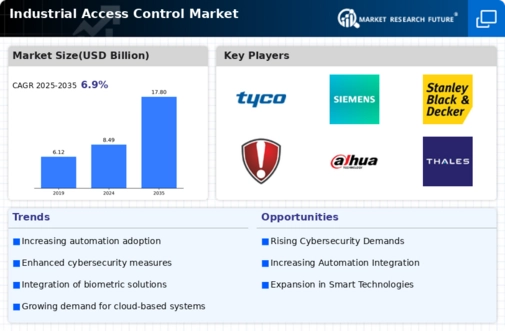
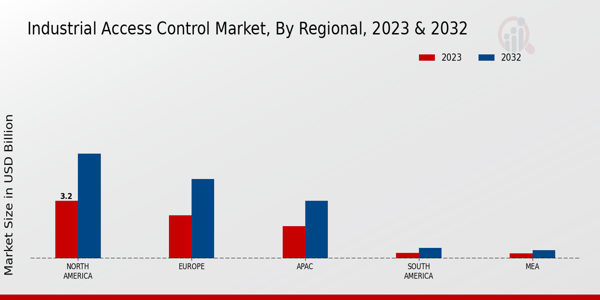
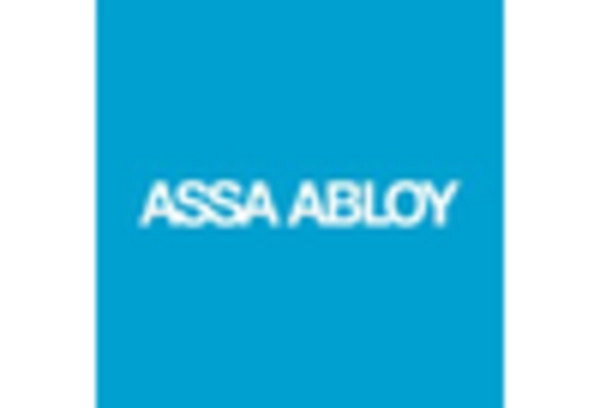
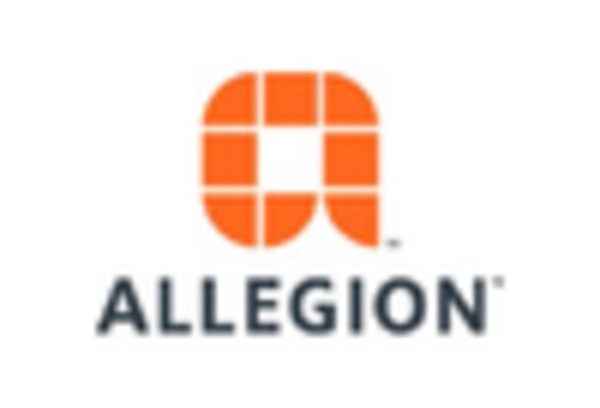
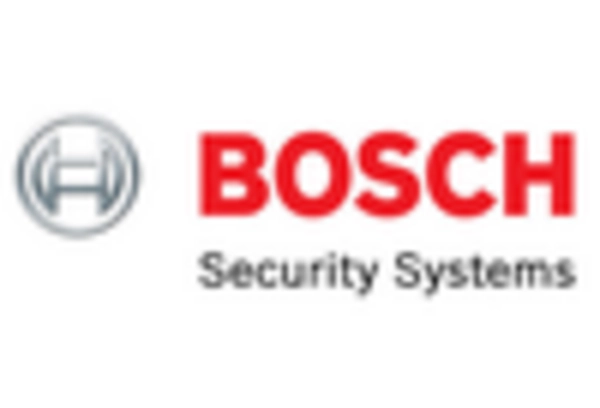


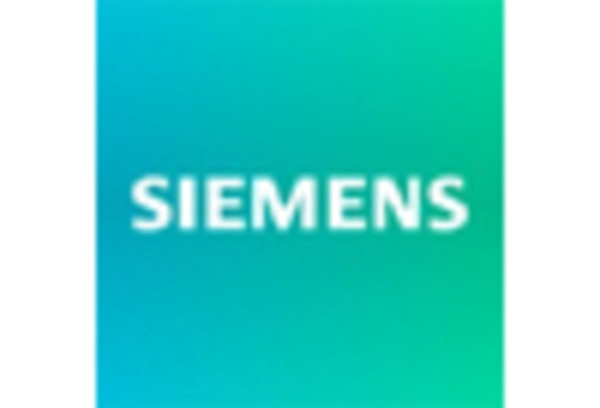

Leave a Comment